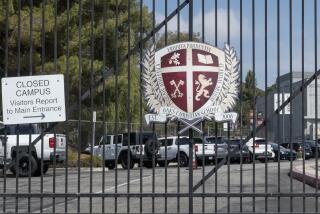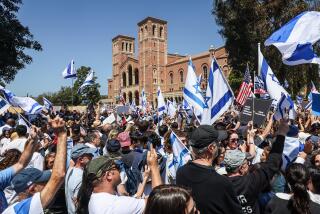Police ‘Black List’ Opens Students’ Eyes to Racism in College Town : Civil rights: Campus provides authorities with a list of every black male student after white woman says black man attacked her.
- Share via
ONEONTA, N.Y. — Darryl Taylor will never forget the welcome he received at the State University of New York at Oneonta.
Just two weeks after arriving on campus last fall, Taylor was summoned from the shower by two state troopers investigating an attack on an elderly white woman, allegedly by a black man. They asked the freshman where he was Sept. 4, checked his hands for cuts, and left.
“I was scared,” said Taylor, a business economics major from Brooklyn. “I thought they were confusing me with someone else for something I knew I didn’t do.”
But police weren’t confusing Taylor with anyone. The 77-year-old woman told police her knife-wielding assailant was a young black man. She said she cut him on the hand before he fled.
Taylor fit the description. He is black.
So are 124 of his fellow classmates, whose names and addresses were handed over to state police by school officials. The 350 or so other black men in this predominantly white college town in Upstate New York, 70 miles west of Albany, also were considered suspects.
Six months later, the reverberations from the so-called “black list” still register. And for some time, authorities will have to deal with the resulting lawsuits and the anger of Oneonta’s black men.
Over a four-day period, almost every one of them was stopped, questioned and searched by state police, some of them two and three times. No one was arrested.
Taylor said he didn’t realize that the characteristic that qualified them for such treatment was skin color until he started swapping stories with other black students.
Word spread quickly among black men that if they didn’t want to be stopped, they should walk with their hands in full view so police wouldn’t think they were hiding anything, Taylor said.
“What a welcome,” he said. “It made me say, ‘Wake up.’ It was racist and it made me see the world for what it really is if you’re black. It smacked me on the face, and I don’t like being smacked on the face.”
Maj. Joseph Loszynski, who heads the state police barracks that conducted the investigation, acknowledged that federal law forbids the distribution of a list such as the one Oneonta State provided.
But he said that if he had it to do all over again, the investigation would have been conducted the same way.
“If the roles were reversed and the same circumstances . . . I would have made as many attempts to interview its occupants--even if they were white,” Loszynski said.
He denied that the investigation was racist.
“I don’t think that that is an unsound police practice,” he said.
Gov. Mario Cuomo disagrees. “Maybe their hearts were pure,” Cuomo said. “But it was obviously inappropriate . . . to say there was some black people involved and then all of a sudden you’re pulling records and in effect making accusations.”
To others like Scott Fein, a lawyer representing the black students, the investigation was a throwback to the Deep South prior to the Civil Rights era.
In those days, black men were routinely stopped by police on the “suspicion” that they had committed rapes. They didn’t dare look an officer in the eye for fear of looking suspicious and stepped into the street gutters when a white woman passed to avoid even the simplest contact.
So when Larry Plaskett was questioned by police on the street, the moment had unpleasant historical echoes. He said he was afraid to walk home for fear that police would come knocking on his door.
“I was almost home when a cop car came driving up the street,” said Plaskett, a student from Far Rockaway in New York City. “I walked around the block because I didn’t want them to know where I lived.”
Like Plaskett, most of the black students are from metropolitan New York. They seek educations that could help them escape the poverty, violence and crime that statistics show leads more black men to jail than to college.
The students are seeking unusual redress in the state and federal lawsuits they are filing. In addition to funds for Oneonta State’s multicultural center, they want 125 State University of New York scholarships for their families and friends.
The full-tuition awards would force college officials to remember the injustice done to black male Oneonta State students, Fein said.
Oneonta State President Alan Donovan said he tried to atone for the “black list” by suspending and demoting Vice President Leif Hartmark, who compiled the list and handed it over to troopers.
The school also has taken steps to increase sensitivity at the college, including training for faculty and staff, increased minority hiring, increase funding for minority programs and counselors for the students.
But Donovan said the “black list” investigation was just a small drop in the well of small-town racism.
“That isn’t an excuse for what happened here, because it was inexcusable,” Donovan said. “But it happens all over. Unfortunately, Oneonta is not unique.”
Taylor agreed. He said he was going to earn his degree to beat the odds stacked against him, “to make sure I never get smacked in the face again.”
“But I won’t be shocked or surprised if it happens again,” he said. “Oneonta is America.”
More to Read
Sign up for Essential California
The most important California stories and recommendations in your inbox every morning.
You may occasionally receive promotional content from the Los Angeles Times.













